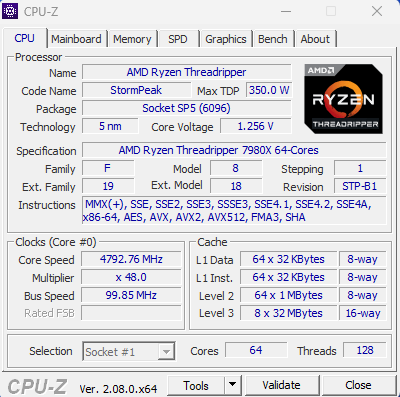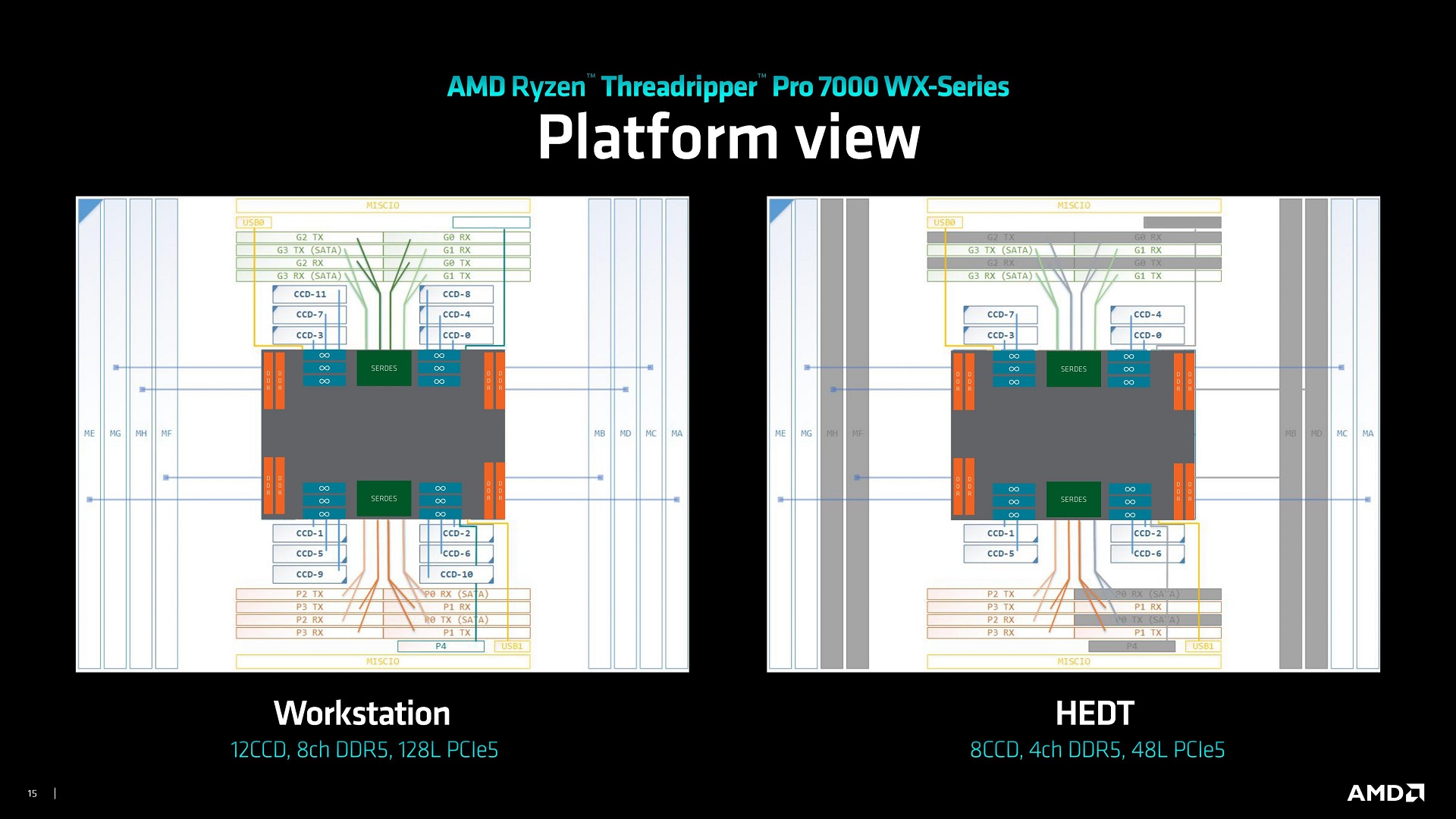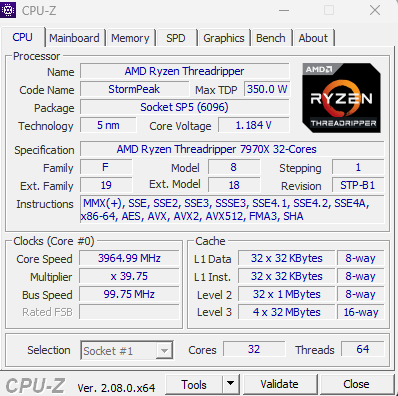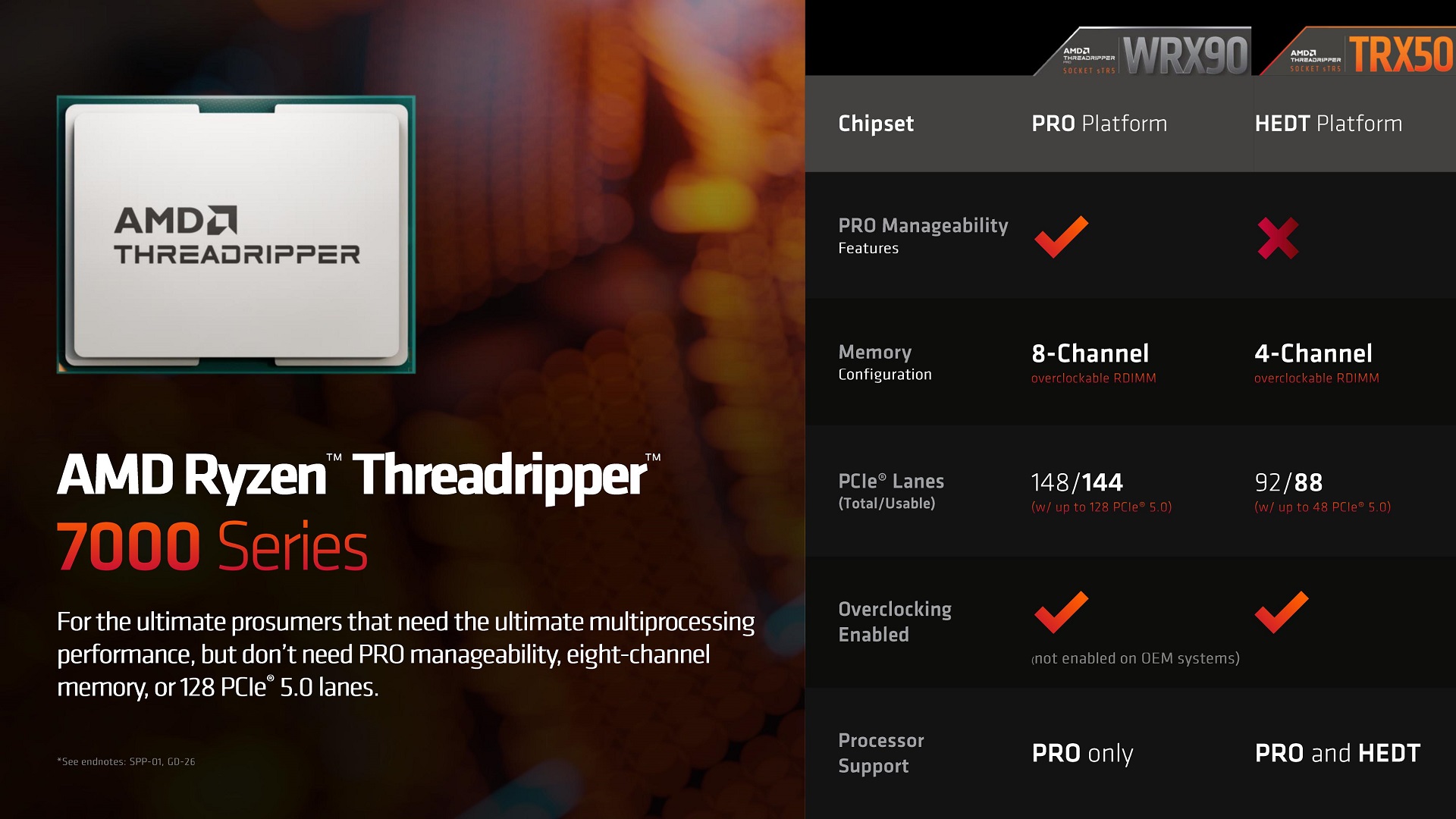AMD’s Ryzen Threadripper 7000 processors mark the current additions to the high-end desktop (HEDT) market, a section AMD wishes to remind the mainstream. Based upon AMD’s tested Zen 4 architecture and constructed on TSMC’s 5nm procedure, both of AMD’s brand-new Ryzen Threadripper 7000 lineups — Pro and non-Pro — are created to bring more cores and more I/O to the high-end desktop and workstation markets. Entirely, AMD is providing 3 brand-new Ryzen Threadripper 7000 SKUs, the top-end 7980X with 64 cores, the mid-tier 7970X with 32 cores, and the entry-level chip in the line-up, the 24-core 7960X.
As has actually held true for the vanilla Threadripper series given that its beginning, the function of AMD’s server-derived processors is to satisfy the needs of desktop users who need severe multitasking abilities and high throughput for complicated work, providing more CPU cores, more memory channels, and more PCIe lanes than what otherwise includes AMD’s desktop platform. At the very same time, the standard Threadripper lineup separates itself from the expert workstation-focused Threadripper Pro chips– in this case, AMD’s brand-new Threadripper 7000 WX-series– by overlooking a few of the more ‘Pro’ includes that featured that hardware, along with a few of the CPU/memory/IO hardware that the much more effective Pro chips provide. Segmenting both line of product is an excellent concept, offered the pedigree and usage cases of both the Pro WX-series and non-Pro chips are lined up with. With Threadripper 7000, AMD targets consumer bases that require CPUs more effective than a desktop Ryzen processor however not as unique (or costly) as what’s basically a complete server-grade chip.
After taking a break in the previous generation, AMD is as soon as again providing a HEDT-focused line-up to customers, which is as grand as it is fascinating. When AMD released the Zen 3-based Threadripper 5000 series, AMD just ever launched the workstation-focused Pro parts, leaving users searching for semi-affordable high-core count CPUs in the dust. This time, AMD has actually chosen to bring the HEDT back, developing a set of Threadripper lines comparable to the Threadripper 3000 household in 2019.
Today in our AMD Ryzen Threadripper 7000 series evaluation, we’re going to be concentrating on the leading 2 chips from the trifecta, the top-end Ryzen Threadripper 7980X (64C/128T) and the middle of the roadway 7970X (32C/64T). We’ll be comparing them to the previous Ryzen Threadripper 3000 series and straight versus Intel’s Sapphire Rapids Workstation CPUs, consisting of the flagship Intel Xeon w9-3495X. Likewise, we’ll be putting them versus the desktop flagships, such as the Intel Core i9-14900K and the AMD Ryzen 9 7950X, to see just how much more efficiency AMD’s brand-new venture into HEDT users can eject. Exists an appropriate location in the market for HEDT chips, offered how far desktop processors have advanced within the last number of years? Let’s discover.
AMD Ryzen Threadripper 7000 Series: Bringing HEDT Back
After AMD avoided launching a vanilla Threadripper processor as part of their Zen 3 architecture household– what would have been the Ryzen Threadripper 5000 series– things definitely looked dim for the future of the high-end desktop (HEDT) market. Integrated with Intel likewise avoiding HEDT that generation by not lowering their distressed Ice Lake server silicon to HEDT items, and it was appearing like HEDT might have lastly been pressed out by more effective desktop processors. However a generation later on, and things have actually apparently altered for the much better for the HEDT market. Wanting to even more profit from the success of their Zen 4 architecture, AMD is reviving HEDT designs to the marketplace through the Threadripper 7000 series, with 3 brand-new chips varying as much as 64C/128T, all with complete Zen 4 cores.
The AMD Ryzen Threadripper 7980X, 7970X, and 7960X are the current entries in the HEDT market, bringing considerable improvements in processing power and performance. The 7980X is the leading SKU with 64 cores/128 threads, a turbo clock speed of as much as 5.1 GHz, and a base clock of 2.5 GHz. The 7970X has half the cores and threads, for 32 cores/64 threads completely, and uses a greater base frequency of 3.2 GHz and matches its higher-end equivalent’s 5.1 GHz turbo clock.

AMD Ryzen Threadripper 7980X (64C/128T) CPU-Z Screenshot
These chips are targeted at driving requiring multi-threaded applications that can fill high core count CPUs, such as sophisticated material development, 3D making, and complicated computational jobs. The 7980X, the more effective of the 2, is especially matched for circumstances needing severe multitasking and high throughput.
On The Other Hand, though AMD isn’t tasting it for today’s evaluation embargo, the Threadripper 7960X represents the opposite of the coin. With 24 cores/48 threads, a base frequency of 3.2 GHz and a turbo clock speed of as much as 5.3 GHz, the 7960X uses the least cores, however still all of the memory bandwidth and I/O lanes the Threadripper platform can supply, making it particularly well matched for jobs where information throughput instead of raw CPU efficiency is the traffic jam. Still, with less CPU cores, it’s the entry-level part (if you can call it that) to AMD’s brand-new HEDT platform, with an MSRP of $1499.
| AMD Ryzen Threadripper 7000 (Zen 4) | ||||||||
| AnandTech | Cores | Base Freq |
Turbo Freq |
PCIe ( Gen 5) |
Cache ( L3) |
TDP | DRAM ( RDIMM) |
Rate ($) |
| 7980X | 64/ 128 | 2500 | 5100 | 48 | 256 MB | 350W | 4 x DDR5-5200 | $ 4999 |
| 7970X | 32/ 64 | 3200 | 5100 | 48 | 128 MB | 350W | 4 x DDR5-5200 | $ 2499 |
| 7960X | 24/ 48 | 3200 | 5300 | 48 | 128 MB | 350W | 4 x DDR5-5200 | $ 1499 |
Relating to memory and I/O abilities, the Threadripper 7000 series supports quad-channel DDR5 memory and as much as 48 PCIe 5.0 lanes, providing a lot of bandwidth for gadgets such as storage and graphics. Distinct to the Threadripper 7000 platform (versus AMD’s customer platform), AMD supports RDIMMs here, enabling the for assistance for as much as 1 TB of memory through DDR-5200 RDIMMs– over 5x as much memory as desktop Ryzen.
These processors represent AMD’s dedication to pressing the ability of desktop computing power, accommodating both specialists, lovers, and whatever in between. They are created for users who need more than what basic desktop CPUs can provide. The Ryzen Threadripper 7980X and 7970X are created to master multi-threaded work. Their theoretical capability to deal with more varied and extensive work than desktop processors makes them a critical option in the existing HEDT landscape.
One action above this is the Threadripper 7000 Pro WX series, which has assistance for 8 channels of memory, pressing the efficiency where work, guideline sets, and applications can take advantage of both more memory bandwidth and greater memory densities.
The TRX50 Chipset: Developed For Threadripper 7000, Supports TR Pro 7000 WX-Series
Releasing together with the brand-new Threadripper chips is AMD’s TRX50 chipset. The TRX50 platofrm utilizes the brand-new 4844 pins sTR5 socket, which like the Threadripper processors themselves, is originated from AMD’s EPYC offerings– in this case the SP6 socket AMD presented for their lower-priced EPYC 8004 (Siena) processors. Regardless of the similar pin count, it needs to be kept in mind that sTR5 and SP6 are not pin suitable.
On the other hand, taking a look at things on a generational basis, there is a degree of cooler compatibility. Particularly, older socket sTRX4 Threadripper coolers will still fit on the 58.5 mm x 75.4 mm sTR5 socket. This implies users updating from sTRX4 chips must in theory have the ability to recycle their old cooler. Nevertheless, they would definitely require to be efficient in supporting a greater TDP of 350 W.

Platform diagram of the WRX90 (left) and TRX50 (right)
For memory and I/O, the TRX50 platform supports 4-channel DDR5 memory and 80 PCIe lanes. Though the latter wind up being an unforeseen mix of PCIe 5.0 lanes and PCIe 4.0 lanes, with 48x PCIe 5.0 lanes together with an additional 32x PCIe 4.0 lanes. As PCIe Gen5 is more complicated to execute and longer runs need re-drivers, AMD has actually decided to restrict the production expenses of motherboards by not running rather numerous max-speed PCIe lanes. At the very same time, the concept of TRX50, particularly when straight compared to WRX90 for Threadripper Pro 7000 WX-series chips, is that it is a cut-down variation to supply whatever users require on a middle-abridged chipset in between desktop AM5 and WRX90 — indicating that calling back some PCIe lanes to 4.0 likewise offers some function distinction in between the 2 Threadripper lineups.

AMD Ryzen Threadripper 7970X (32C/64T) CPU-Z Screenshot
It deserves highlighting that Threadripper 7000 Pro chips can likewise be utilized in TRX50 motherboards. However, obviously, they will undergo the very same memory channel and I/O restrictions. In that regard, TRX50 boards can be utilized as a budget plan board pairing for Threadripper Pro chips. Otherwise, the reverse is incorrect: non-pro Threadripper 7000 chips can not be utilized in WRX90 boards, as illogical as that would be.
Test Bed and Setup
We utilize the following test systems for our AMD Ryzen Threadripper 7980X, 7970X, and Intel Xeon WS-series screening:
| AMD Ryzen Threadripper 7000 Series | Intel Sapphire Rapids Xeon Series | |
| CPU | Ryzen Threadripper 7980X ($ 4999) 64 Cores, 128 Threads 350 W TDP Ryzen Threadripper 7970X ($ 2499) |
Xeon W9-3495X ($ 5889) 56 Cores, 112 Threads 350 W TDP |
| Motherboard | ASUS Pro WS TRX50-SAGE WIFI | ASUS Pro WS W790E-SAGE SE |
| Memory | G.Skill Zeta R5 Neo 4×32 GB DDR5-5200 RDIMM |
SK Hynix 8×16 GB DDR5-4800 RDIMM |
| 6 | NZXT Kraken 360 360mm AIO | Noctua NH-U14S DX-4677 |
| Storage | SK Hynix Platinum P41 2TB PCIe 4.0 x4 | |
| Power Supply | MSI A1000G 1000W | |
| GPUs | AMD Radeon RX 6950 XT, 31.0.12019 | |
| Platforms | Windows 11 22H2 | |
For our head-to-head contrast, we have on hand Intel’s newest Sapphire Rapids Xeons. Like the Threadripper series, the Xeons are broken up into 2 sub-groups– the full-fat Xeon w-3000 series for high-end workstations, and the lighter Xeon w-2000 series for more mainstream workstations. Regrettably, the only Xeons we have on hand are the w-3000 series parts (which is what Intel tested for examining when those were launched), so it’s not rather an apples-to-apples contrast, particularly as the w-3000 Xeons support 8 channels of memory (versus TR’s 4 channels).
Still, there are resemblances in core and thread count and TDP that must provide some informing information. Both platforms have a max TDP of 350W, and the Intel W9-3495X we’re utilizing is a 56C/112T chip, while the Threadripper 7980X is a 64C/128T chip.
For included taste, we’ll be including information from both AMD and Intel’s flagship desktop processors, consisting of the Core i9-14900K, the Ryzen 9 7950X, and Ryzen 9 7950X3D. We will likewise be comparing the brand-new AMD Threadripper 7000 series chips to their previous equivalents, consisting of the AMD Ryzen Threadripper 3990X (64C/128T), which we examined in 2020, along with the Threadripper 3970X (32C/64T).
Keep Reading for our prolonged analysis.
